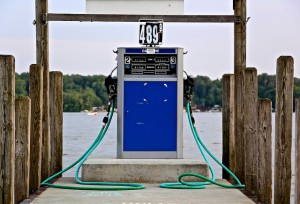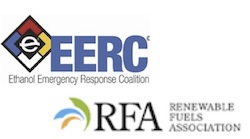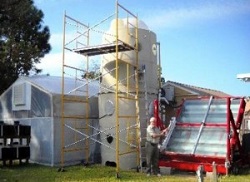Syngenta and Quad County Corn Processors (QCCP) are collaborating to produce cellulosic ethanol from corn kernels as well as to license the technology to other ethanol plants. The first-of-its-kind technology is known as Adding Cellulosic Ethanol and was developed by QCCP, who expects to produce one million gallons of cellulosic ethanol in 2014 and two million gallons in 2015.
This breakthrough was made possible through the integration of Adding Cellulosic Ethanol technology at QCCP, a 35 million gallon per year capacity ethanol production facility. The introduction of the technology  will enable QCCP to increase ethanol yield per bushel by six percent, produce an additional two million gallons of cellulosic ethanol per year and realize a number of other important benefits including increased production of corn oil and distillers grains (DDGs).
will enable QCCP to increase ethanol yield per bushel by six percent, produce an additional two million gallons of cellulosic ethanol per year and realize a number of other important benefits including increased production of corn oil and distillers grains (DDGs).
Delayne Johnson, CEO of QCCP discussed the technology during a press conference held at the Iowa Speedway last Friday. The event was part of the American Ethanol 200 presented by Enogen sponsorship. The NASCAR Camping Truck World Series races on E15.
“Adding Cellulosic Ethanol technology will help us to increase the protein content of dried distillers grains (DDGs) by 40 percent, improve corn oil extraction by 200 percent and realize more ethanol out of the same kernel of corn,” said Johnson. “The commercialization of this technology represents a major advance in the production of cellulosic ethanol. For example, Adding Cellulosic Ethanol technology could produce one billion gallons of cellulosic ethanol by converting the corn kernel cellulose from corn currently being processed in existing dry grind ethanol plants. And, once hemicellulosic yeast is FDA-approved, Adding Cellulosic Ethanol will be capable of producing an additional one billion gallons – all from corn already being processed.”
Johnson said tests have also shown that Adding Cellulosic Ethanol technology, in conjunction with Enogen® trait technology, will deliver significant benefits to ethanol plants beyond what can be achieved through either technology alone.
“The combination of Adding Cellulosic Ethanol and Enogen corn is expected to generate significant synergies when used together in dry grind ethanol plants,” Johnson added. “It will produce advanced and cellulosic ethanol while decreasing natural gas usage, increasing ethanol throughput and reducing an ethanol plant’s carbon footprint. These advantages, combined with higher protein DDGs and increased corn oil production, make the technology package appealing for ethanol plants looking to improve their bottom line.”
 Cellulosic Ethanol Technologies is a wholly-owned subsidiary of Quad County Corn Processors. Earlier this year, Syngenta announced an agreement with Cellulosic Ethanol Technologies to license Adding Cellulosic Ethanol technology to ethanol production facilities.
Cellulosic Ethanol Technologies is a wholly-owned subsidiary of Quad County Corn Processors. Earlier this year, Syngenta announced an agreement with Cellulosic Ethanol Technologies to license Adding Cellulosic Ethanol technology to ethanol production facilities.
“Ethanol is helping America reduce its dependence on foreign oil, lowering prices at the pump, improving the environment with lower emissions, and growing the economy with jobs that can’t be outsourced,” said Jack Bernens, head of marketing and stakeholder relations for Enogen Trait Technology at Syngenta. “The combination of Adding Cellulosic Ethanol technology and Enogen could represent the next leap forward for ethanol production.”
Listen to my interview with Delayne Johnson here: Delayne Johnson interview
Visit the 2014 American Ethanol 200 presented by Enogen photo album.

 Biodiesel behemoth Renewable Energy Group (REG) could be looking to expand one of its Illinois biodiesel plants. This article in the Champaign (IL) News-Gazette says REG is buying up lots around its Danville biodiesel plant, as well as asking city officials to vacate alleys and portions of streets around the facility and change the local zoning from residential to industrial. The city council last night unanimously reversed the city’s planning and zoning commission’s original denial of the request back in June.
Biodiesel behemoth Renewable Energy Group (REG) could be looking to expand one of its Illinois biodiesel plants. This article in the Champaign (IL) News-Gazette says REG is buying up lots around its Danville biodiesel plant, as well as asking city officials to vacate alleys and portions of streets around the facility and change the local zoning from residential to industrial. The city council last night unanimously reversed the city’s planning and zoning commission’s original denial of the request back in June. 










